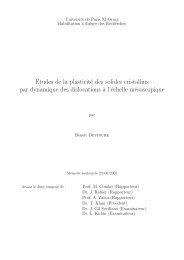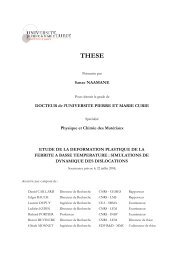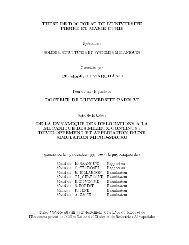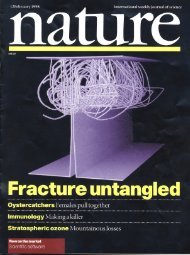Acta Materialia, 58(17) - Laboratoire d'Etude des Microstructures
Acta Materialia, 58(17) - Laboratoire d'Etude des Microstructures
Acta Materialia, 58(17) - Laboratoire d'Etude des Microstructures
Create successful ePaper yourself
Turn your PDF publications into a flip-book with our unique Google optimized e-Paper software.
5594 S. Queyreau et al. / <strong>Acta</strong> <strong>Materialia</strong> <strong>58</strong> (2010) 5<strong>58</strong>6–5595<br />
Table 4<br />
Comparison of the prediction of usual rule of mixtures prediction with DD simulation results when combining forest and carbide strengthening. The<br />
different forest reactions considered are dipolar interaction, collinear annihilation, mixed asymmetric junction, edge junction and mixed symmetric<br />
junction with three increasing particle densities. The flow stress values for the DD simulation are taken at c = 0.25% and are given in MPa.<br />
Rules of mixtures k =1 k = 3/2 k = 2 Monnet DD<br />
Dipol. + Carb. 53 44 40 27 40 ± 1<br />
Colli. A. + Carb. 99 80 77 70 78 ± 3<br />
Asym. J. + Carb. <strong>58</strong> 47 44 32 48 ± 2<br />
Edge J. + Carb. 60 48 45 34 48 ± 2<br />
Sym. J. + Carb. (3 10 11 m 2 ) 39 31 30 28 35 ± 3<br />
Sym. J. + Carb. (3 10 12 m 2 ) 65 52 48 38 52 ± 3<br />
Sym. J. + Carb. (3 10 13 m 2 ) 130 110 107 97 118 ± 4<br />
The quadratic form (k = 2) first proposed by Koppenaal<br />
and Kuhlmann-Wilsdorf [46] assumes that the obstacle<br />
families have very similar strength. When the obstacles<br />
have identical planar densities, this yields the form proposed<br />
by Labush [47] with k = 3/2. More recently, Monnet [13]<br />
proposed a generalized rule of mixtures, in which the<br />
strength of obstacles is balanced by their concentration. It<br />
qffiffiffiffiffiffiffiffiffiffiffiffiffiffiffiffiffi<br />
follows s ¼ðs 1 l 2 þ s 2 l 1 Þ= l 2 1 þ <br />
l2 2<br />
, where l is the average<br />
spacing between the obstacles of each obstacle family.<br />
Comparison between these different rules of mixtures and<br />
the simulation results are reported in Table 4. It should be<br />
noted that the linear rule and the solution proposed by Monnet<br />
[13] give poor evaluation of the flow stress. Conversely,<br />
the rules with k = 3/2 and k = 2 lead to rather good prediction<br />
with all tested combinations. Such agreement with all<br />
the simulations is remarkable since the specific strength of<br />
the two hardening mechanisms tested in the simulation are<br />
very different. First, the range of particle densities explored<br />
lies within two orders of magnitude. Secondly, the difference<br />
between the flow stress induced by dipolar interactions and<br />
collinear annihilations is significant, i.e. 46 MPa. The two<br />
rules of mixtures with k = 3/2 and k = 2 are numerically difficult<br />
to distinguish and one can easily check that this is<br />
because the two forms give very similar predictions for a<br />
wide range of stresses [0, 1000 MPa]. As a result, their difference<br />
never exceeds 12%. Considering that the quadratic law<br />
has already proved its reliability in the case of multiple dislocation–dislocation<br />
interactions [48], the rule of mixtures<br />
form with k = 2 is preferred in the final section of this paper.<br />
a plateau at a stress level around 100 MPa is reached. Note<br />
that the primary dislocation density at c = 1% is increased<br />
by a factor 12. However, no strain hardening can be precisely<br />
calculated from this curve because of the presence<br />
of quite large stress fluctuations. Plastic deformation proceeds<br />
by bursts and the simulated reference volume is too<br />
small to smear out plastic avalanches.<br />
Considering the results reported in previous sections, the<br />
total flow stress s in the present single slip simulation<br />
should be calculated with:<br />
qffiffiffiffiffiffiffiffiffiffiffiffiffiffi<br />
s ¼ s i ¼ s sol:sol: þ s 2 p þ s2 f<br />
ð8Þ<br />
where s i is the critical stress on the active slip system i, s p is<br />
the particle strengthening contribution calculated from Eq.<br />
(5) and s f is the forest hardening contribution calculated<br />
from Eq. (7).<br />
For the purpose of validating Eq. (8), it is worth noting<br />
that only the carbi<strong>des</strong> and the slip system densities need to<br />
be defined. As the latter quantities are explicit variables of<br />
DD simulations, one can immediately test the prediction of<br />
Eq. (8) by monitoring the slip system densities during computation,<br />
and compare these with the simulated stress–<br />
strain curves reported in Fig. 8. Clearly, the quadratic rule<br />
6. Validation of the quadratic mixture law<br />
In this final section, the robustness of the quadratic rule<br />
of mixtures is tested with the most complex computation<br />
we have used to simulate plasticity of RPV steel. A tensile<br />
test simulation is made with the loading axis at the center<br />
of the standard triangle, [1511], hence imposing a single<br />
slip condition. The initial dislocation microstructure contains<br />
the 12 1/2 h1 11if110g slip systems. The total dislocation<br />
density is initially 10 14 m 2 and the carbide size and<br />
density are respectively of 0.1 lm and 3 10 12 m 2 .<br />
The corresponding stress–strain curve is reproduced in<br />
Fig. 8. The flow stress increases up to c = 0.25 %, where<br />
Fig. 8. Comparison of the simulated flow stress with the prediction of a<br />
quadratic rule of mixtures accounting for Orowan and forest hardening.<br />
The tensile test simulated corresponds to single slip condition and<br />
accounts for carbi<strong>des</strong> and dislocations microstructures consistent with<br />
observations made in RPV steel.









